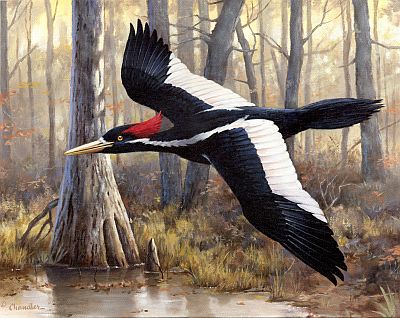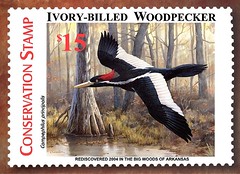Special Announcement: Ivory-billed Woodpecker Fundraising Effort

"Elusive Ivory" by Larry Chandler.
Many people have asked where they can contribute money to help save the Ivory-billed Woodpecker (IBWO) and its habitat. There now is a way that you can help this bird and also receive a reward for doing so; an Ivory-billed Woodpecker Conservation Stamp Print Program was just initiated with this purpose in mind. Basically, you purchase a copy of the IBWO stamp or print
 and your money will be donated to three agencies that are working to save this magnitficent bird and its habitat.
and your money will be donated to three agencies that are working to save this magnitficent bird and its habitat. I interviewed Bob Chapman, webmaster for wildlife artist Larry Chandler, and he said that the IBWO Conservation Stamp program will be similar the Federal Duck Stamp and print program in its scale and importance. As you probably know, revenue from Federal Duck Stamps (required for all waterfowl hunters 16 and over since 1934) fund the majority of National Wildlife Refuges across the country. In fact, the Federal Duck Stamp program is one of the most successful conservation programs ever devised. Since 1934, revenues from the sale of Federal Duck Stamps have been used to acquire millions of acres of natural habitat for America's waterfowl in the National Wildlife Refuge System.
Even though some people think that federal money will provide enough funds to protect the IBWO, establishing strong private sector funding is very important for several reasons; there is much that can be done with private sector funds that cannot be done with federal monies and federal conservation programs tend to be victims of political pressure. So strong private sector funding to provide long-term support for preserving this species is vital to its continued existence.
Funds raised by the IBWO Conservation Stamp program will go where they are needed most; The Cornell Lab of Ornithology, The Nature Conservancy and the Arkansas Game and Fish Foundation. These three entities have all have endorsed this program and all net proceeds will be equally shared between them.
Of course, these three agencies have their own set of priorities for use of their fund shares; Cornell needs more money to research the bird and its habitat. The Nature Conservancy will use their share to purchase additional land to protect the birds' habitat (their specialty) and the Arkansas Game and Fish Commission will hire more game wardens to protect these areas as well as provide more public education.
The great thing about this program is, rather than just making a tax-deductible contribution, people who buy the conservation stamp or print will get something back for their contribution. The print (pictured above) is proof you have done something tangible to help this bird's cause and further, it will make a lovely addition to your decor, too. The limited edition prints are expected to become more valuable in the future on the secondary market, which is an added bonus. For example, the earliest Federal Duck Stamp Prints and the First of State Duck Stamp Prints, which initially cost $15 to $125 each are now worth thousands of dollars.
The lowest print numbers will be assigned to the earliest orders. Each print number is similar to a serial number for your print. As any print collector can tell you, having a low print number doesn't really make a print more valuable per se, but everyone prefers owning a lower print number anyway. There will only be 20,000 signed & numbered Regular Edition prints available. Search team members Tim Gallagher, Gene Sparling, Bobby Harrison and David Luneau and IBWO artist Larry Chandler will sign 2,400 numbered special Search Team Edition prints. There are other options available, too.
Brochures for the Ivory-billed Woodpecker Conservation Stamp Print Program that explain everything in detail will be available soon.
© 2004, 2005, 2006 by GrrlScientist











0 Peer Reviews:
Post a Comment
<< Home